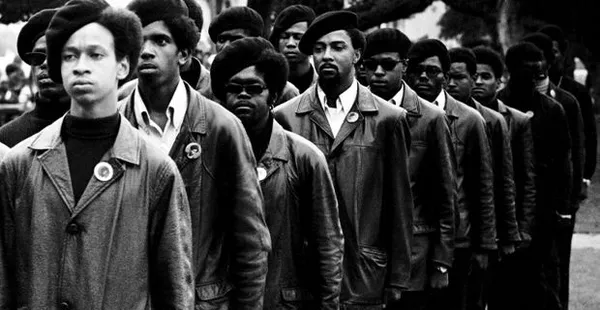Eye For Film >> Movies >> The Black Panthers: Vanguard Of The Revolution (2015) Film Review
The Black Panthers: Vanguard Of The Revolution
Reviewed by: Owen Van Spall

At a time when Ava du Vernay’s feature film Selma has put the spotlight back on to Martin Luther King and his role in the black civil rights struggles of the 1960s, director Stanley Nelson’s documentary on the Black Panthers proves to be a well put together, if somewhat conventional, exploration of another side of the growing black political movement.
Built from archive footage and new interviews with former Black Panther members, attorneys who fought their legal battles and even former police officers who would have been seen by the Panthers as the enemy, the film is an interesting, timely, though ultimately dispiriting look at how the twin forces of institutional bigotry and internal discord fragmented one of the key organising forces in black America.
For the uninitiated, the Black Panther group was born during the highly charged decade of the 1960s, where black political figures such as Martin Luther King and Malcolm X were making their own waves against a backdrop of police and institutional brutality, the war in Vietnam, and entrenched black poverty. Young angry black Americans, tired of the civil rights movement’s perceived softness and slow pace, gathered around a group of charismatic black individuals - Huey Newton, Bobby Seale and Eldridge Cleaver - to form the Black Panther movement.
Nelson’s film sketches out how the Panthers were, at the start at least, a potent mix of an aggressive poise with a savvy awareness of style and how to manipulate the media. Before long, their signature look of black leather trenchcoats, berets and afros had won them thousands of new recruits who were fired up by the Panthers provocative stances on carrying guns (possible by cunningly exploiting liberal state weapon carrying laws) and allowing women to take frontline roles. The media took note, and Newton and other leader figures were soon gracing magazine covers and winning over not just new recruits, but left-leaning white elite figures.
Confrontations with the police, frequent arrests of members (on trumped up charges usually) and sensational gestures such as marching armed into an Oakland court house, gave the Panthers a certain reputation. But Nelson’s film admirably reminds viewers that the organisation had wider objectives, such as providing food banks, healthcare, and education. Their printed manifesto also focused on poverty, jobs and police brutality; hardly crazy aims.
Though Newton, Seale and Cleaver do not appear to speak for themselves in recent interviews (Cleaver and Newton being dead), various interviewees describe how the movement was let down by leaders not worthy of the hard working rank and file. Cleaver and Newton split over the direction of the movement, and Seale, after serving time in prison, staked a huge amount of the organisation’s time and money on a mayoral run in California that went nowhere. Newton descended into drugs and paranoia. Cleaver, many interviewees claim, was unstable and unnecessarily inflammatory. But Nelson’s film, in its most provocative sections, charts how there was a force working against the Panthers behind the scenes that all of these flawed leaders underestimated: the ogre-like figure of J Edgar Hoover and his FBI.
The tactics Hoover pushed, seen here in documents and described by interviewees, make for disturbing reading: a programme of disruptive counterintelligence - under the umbrella term COINTELPRO - designed to turn the Panthers and similar groups inside out through disinformation, harassment and inside men ‘moles’. All to prevent what Hoover called the dangers of the rise of “a black messiah”. And these tactics may have gone further than that: when Panther leader Fed Hampton was killed in Chicago after his house was stormed, many Panthers and civil rights activists called it the work of a city police death squad organised by the FBI, with a legal suit eventually being settled later for over $1 million dollars with Hampton’s family. The FBI gutted the Panther’s from the inside out, with internal divisions and self-destructive tendencies of the leadership doing the rest.
It is hard not to feel thoroughly depressed at the end of Nelson’s film, as it effectively lays bare the strength and viciousness of the establishment and its agencies when it comes to clamping down on a force proposing an alternative to the status quo. But it serves as an important document precisely because of this. Carried along by an evocative soundtrack, the film deserves praise for its excellent collection of archive material and for gathering a mix of interviewees who have both negative and positive opinions on the Panther legacy, and offer a range of opinions on why the Panthers rose and fell. Whether the true messy story of the Panthers and their time can be told in a 90-minute documentary like this is an open question, but its present day relevance is painfully obvious.
Reviewed on: 07 Jun 2015
















